Annaberg-Buchholz
| Annaberg-Buchholz | ||
|---|---|---|
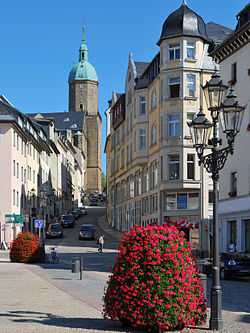 | ||
| ||
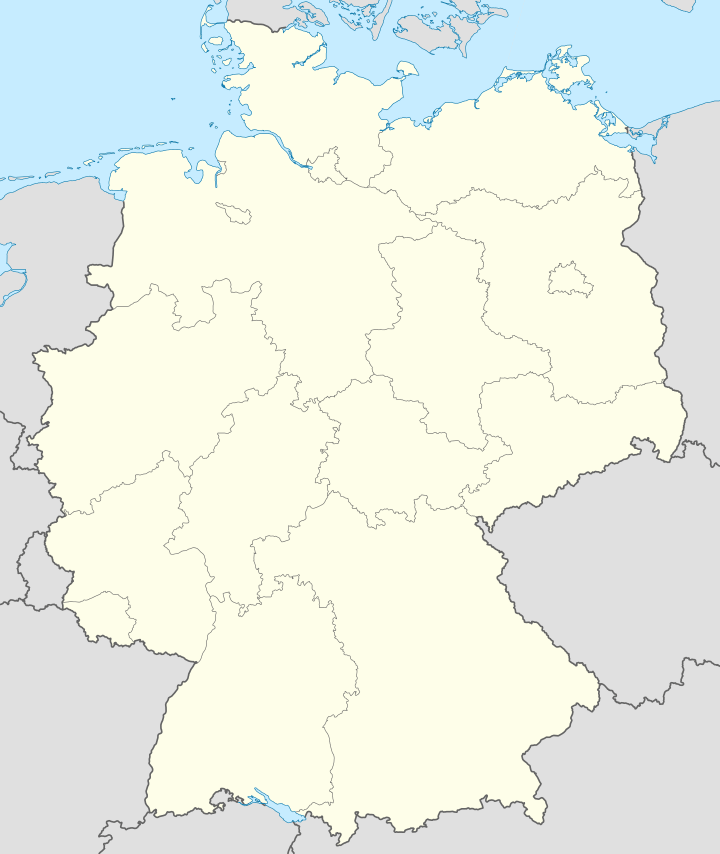 Annaberg-Buchholz | ||
Location of Annaberg-Buchholz within Erzgebirgskreis district  | ||
| Coordinates: 50°34′48″N 13°0′8″E / 50.58000°N 13.00222°ECoordinates: 50°34′48″N 13°0′8″E / 50.58000°N 13.00222°E | ||
| Country | Germany | |
| State | Saxony | |
| District | Erzgebirgskreis | |
| Government | ||
| • Mayor | Barbara Klepsch (CDU) | |
| Area | ||
| • Total | 27.70 km2 (10.70 sq mi) | |
| Population (2013-12-31)[1] | ||
| • Total | 20,510 | |
| • Density | 740/km2 (1,900/sq mi) | |
| Time zone | CET/CEST (UTC+1/+2) | |
| Postal codes | 09456 | |
| Dialling codes | 03733 | |
| Vehicle registration | ERZ, ANA, ASZ, AU, MAB, MEK, STL, SZB, ZP | |
| Website | www.annaberg-buchholz.de | |
Annaberg-Buchholz (German pronunciation: [ˈanabɛɐ̯k ˈbuːx.hɔlts]) is a town in the Free State of Saxony, Germany, in the Ore Mountains, and is the capital of the district of Erzgebirgskreis.
The town is located in the Ore Mountains, at the side of the Pöhlberg (832m above sea level). It has three Protestant churches, among them that of St. Anne's, built 1499-1525 (which is also the largest of its kind in the Federal State of Saxony), a Roman Catholic church, several public monuments, among them those of Luther, of the famous mathematician Adam Ries, and of Barbara Uthmann. Annaberg is well known for its historical old town and market square, the house Markt 2 shows the coat of arms of the family Apian-Bennewitz.
Annaberg, together with the neighbouring suburb, Buchholz, is the chief seat of the braid- and lace-making industry in Germany, introduced here by Barbara Uthmann in 1561, and further developed by Belgian refugees, who, driven from their country by the Duke of Alva, settled here in 1590. The mining industry, for which the town was formerly also famous and which embraced tin, silver and cobalt, has now ceased. A couple of mines have been restored after the break of the wall in 1989 and can be accessed by visitors. Annaberg has technical schools for lace-making, commerce and agriculture, in addition to high grade public schools for boys and girls.
In 1945 the two towns Annaberg and Buchholz merged into the new town Annaberg-Buchholz.
History
Foundation
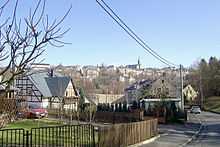
The previously heavily forested upper Ore Mountains were settled in the 12th and 13th centuries by Franconian farmers. The first documented mention of Frohnau, Geyersdorf and Kleinrückerswalde, which are all now part of present-day town of Annaberg-Buchholz was in 1397.
Main sights
The area is a famous tourist destination and a ski resort.
The Ore mountains are referred to as Land of Christmas and famous for their special flair, the Christmas Markets and the carved sculptures.
Museums
- Adam Ries Museum and Annaberg School of Accountancy (Rechenschule)
- Ore Mountain Museum and Im Gößner visitor mine
- Manufaktur der Träume
- Markus-Röhling-Stolln visitor mine at Frohnau
- Dorothea-Stolln visitor mine at Cunersdorf
Frohnauer Hammer
→ Main article Frohnauer Hammer
The Frohnauer Hammer is a historic and fully working preserved hammer mill in the village of Frohnau within the municipality. In 1907 it was declared a technical monument and, since then, has been open to the public. In addition to the actual hammer mill itself, there is an exhibition of forged items and the former master hammersmith's house (Hammerherrenhaus).
Regular events
- An annual high point in early summer is the largest folk festival in the region, the Annaberger Kät.
- Every two years in August the Abbey Festival takes place in the ruins of Annaberg Abbey.
- The Annaberg Christmas Market is widely known outside the region and closes on the fourth week in advent with the world's biggest miners' parade (Bergparade).
International relations
Annaberg-Buchholz is twinned with:
-
 Weiden (Oberpfalz), Germany
Weiden (Oberpfalz), Germany -
 Paide, Estonia
Paide, Estonia -
 Chomutov, Czech Republic
Chomutov, Czech Republic
Pictures
-

St. Anne's Church
-
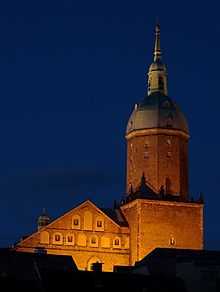
St. Anne's Church
-

St.Mary's Church
-

Uthmann Monument
-

Frohnauer Hammer
-
_2006-11-04.jpg)
Markus Röhling Stolln
-

School building
-
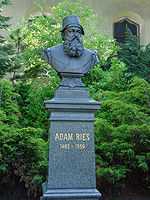
Adam Ries Monument
-

Panoramic view of the city silhouette
References
- ↑ "Statistisches Landesamt des Freistaates Sachsen – Bevölkerung des Freistaates Sachsen jeweils am Monatsende ausgewählter Berichtsmonate nach Gemeinden" (PDF). Statistisches Landesamt des Freistaates Sachsen (in German). 6 September 2014.
![]() This article incorporates text from a publication now in the public domain: Chisholm, Hugh, ed. (1911). "Buchholz". Encyclopædia Britannica (11th ed.). Cambridge University Press.
This article incorporates text from a publication now in the public domain: Chisholm, Hugh, ed. (1911). "Buchholz". Encyclopædia Britannica (11th ed.). Cambridge University Press.
External links
| Wikimedia Commons has media related to Annaberg-Buchholz. |
| ||||||||
| ||||||||